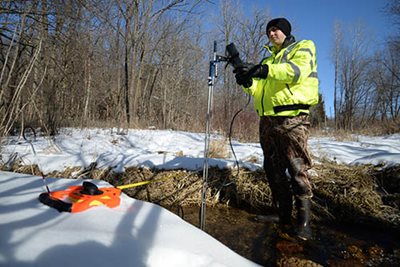 Excess salt in our waterbodies threatens our environment. It damages infrastructure, compromises drinking water, and threatens pets, wildlife, and aquatic organisms. Unfortunately, many of our local streams have excess chloride levels – and the situation continues to worsen.
Excess salt in our waterbodies threatens our environment. It damages infrastructure, compromises drinking water, and threatens pets, wildlife, and aquatic organisms. Unfortunately, many of our local streams have excess chloride levels – and the situation continues to worsen.
Over two decades, the Met Council studied chloride concentration levels and trends for 18 streams in the seven-county metropolitan area. The recently published report — Regional Assessment of Chloride in Select Twin Cities Metro Streams (1999 – 2019, PDF) — reveals that nearly all the streams are experiencing rising chloride levels.
“This is an alarming trend,” said Peter Lindstrom, chair of the Met Council’s Environment Committee. “What’s worse is that there’s no good way to remove chloride pollution in water, so it’s imperative that we work collectively to reduce the source of the problem.”
Excess chloride transcends local steams. Currently, 42 Twin Cities waterbodies, which include lakes, rivers, ponds, and streams, are contaminated with excess chloride levels.
“Actually, the number is very likely significantly higher,” Lindstrom said. “Only about 10% of the waterbodies in the seven-county metropolitan area have been sampled for chloride. We will continue to conduct further studies to assess the quality of our local waters.”
Comprehensive study sheds insight into regional chloride pollution
The study was expansive. The watersheds for the 18 streams in the study cover about 50% of the metro area, including seven streams in the Mississippi River Basin, eight in the Minnesota River Basin, and three in the St. Croix Basin. Some of the streams are located in fully urbanized areas while others are in more remote rural areas. In addition, the study includes both streams predominately sourced by groundwater and those more dominated by surface water.
Streams in more urbanized areas tended to have higher chloride concentrations while groundwater-dominated streams tended to have larger increases in trends.
“The study is a great start, and we hope to use its findings to learn even more about our regional waterbodies, as well as our impact on them,” said Judy Sventek, manager of water resources in the Met Council’s Environmental Services division. “We will continue to monitor and assess our waterbodies while working with local agencies and community leaders to curb the disturbing trends.”
Top sources of chloride in waterbodies (statewide)
- De-icing salt (41%)
- Synthetic fertilizer (23%)
- Household water softening (14%)
- Livestock feces and urine (6.5%)
- Permitted industries (6%)
Working collectively to reduce chloride levels
Currently, there are 14 documented chloride sources that pollute our regional streams. A few sources, however, are more prevalent and damaging than others. Other studies have cited de-icing salt as the primary culprit for excess chloride levels in our regional waterbodies. In fact, nearly half of the chloride infiltrating our local streams comes from the household and commercial use of de-icing salt, most frequently used in the winter months.
“Now that we know the extent of the issue, we can move forward to stabilize chloride levels,” said Sventek. “For example, homeowners and business owners can use less de-icing salt on driveways and sidewalks. Property managers and maintenance contractors can become Smart Salt certified. Community leaders can place restrictions on inefficient water softeners for homeowners or incentivize upgrades to more efficient devices.”
Fact sheet: Rising Chloride Levels in Local Streams (PDF)
Water quality management work at Met Council